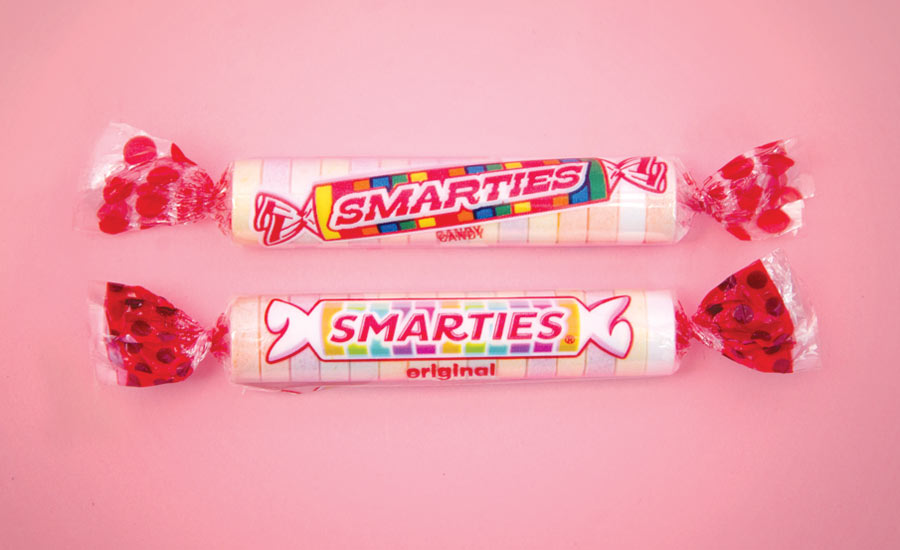Smarties co-presidents take third-generation company into the future
Liz Dee, Sarah Dee and Jessica Dee Sawyer took over the reins in 2017.

Smarties Candy Co. is currently run by a trio of female copresidents: Liz Dee, Jessica Dee Sawyer and Sarah Dee. The family members are the third generation to lead the candy company, and they’re working hard to innovate the well-known brand.

Liz Dee, Sarah Dee and Jessica Dee Sawyer meet weekly to discuss how things are going with company and to fi gure out ways to make the company even better going forward.

Smarties are formed into the famous tablets.

Various Smarties colors are mixed together so that the rolls each feature a variety of fl avors.

The company’s most popular Instagram photo ever features the old logo above the new one, which features an updated font and a modern take on the iconic colors.

Smarties recently debuted new packaging, featuring a more modern design and logo.

Smarties are sorted into rolls.

Smarties are sorted into rolls.

Smarties are made 24 hours a day in two candy factories located in Union, New Jersey and Newmarket, Ontario. The company produces billions of Smarties rolls each year.

Sisters Liz Dee and Jessica Dee Sawyer as well as their cousin Sarah Dee are the three co-presidents of Smarties Candy Co., marking the third-generation to run the candy company.

Liz Dee pours packaged Smarties into a bulk bin.

Packaged Smarties fi ll a bulk bin before being packaged.

A sheet of the Smarties wrappers is ready to be cut and used to package the candies.

Smarties Candy Company is owned and operated by three generations of the Dee family. On January 10, 1949, Edward “Eddie” Dee (pictured here) brought his family from England to New Jersey. Equipped with only two machines in a rented facility, he succeeded in founding Ce De Candy, Inc., makers of Smarties, America’s favorite , America’s favorite candy wafer roll.

Smarties are sorted into bags.

Smarties recently installed a new packaging robot to help automate some of the production process.


















Ever since she was a little girl, Jessica Dee Sawyer always thought she would work for the family business — but she was starting to worry that her sister Liz and her cousin Sarah weren’t going to join her.
“I had my moments of doubt,” she explained.
Liz was “off in France” working on her graduate degree, while Sarah was in southern California working on her career out there.
But in 2005, Sarah and Jessica joined the business months apart, and a few years later, in 2008 Liz came on full time.
It turns out, that’s exactly how their dads, Michael and Jonathan, had hoped it would play out.
“[My dad] never really pushed us,” Sarah said. “He wanted us to find our way back on our own.”
And that they did. The three have been leading Smarties Candy Co. as co-presidents since October 2017, with Sarah overseeing U.S. and Canada production and operations; Jessica in charge of HR as well as U.S. and Canada sales; and Liz in charge of food quality and safety as well as communications.
They have given the nearly 70-year-old family-run company a complete brand re-lift, updating the iconic Smarties logo, making upgrades in the factory and bringing their different perspectives on how to run things.
Today, Smarties are made 24 hours a day in two candy factories, one of which is located in Union, N.J., while the other is in Newmarket, Ontario — although in Canada the brand name is actually Rockets. The company produces billions of the famous candy rolls each year with the help of about 170 total employees in the U.S. and Canada.
The recipe was created by their grandfather Edward Dee, who was himself a third-generation candy maker in England. He spent some time in the U.S. as a child during World War II, and while he did go back the UK after the war, he ended up loving the U.S. so much that he came back a few years later with his wife Anita and their son Jonathan, arriving by boat, this time to New Jersey. Their second son, Michael, was born a year after they arrived.
Equipped with only two machines in a rented facility, he succeeded in founding Ce De Candy, Inc., and Edward opened his first factory in Bloomfield, N.J. in August 1949 before moving the company to Elizabeth, N.J. in 1959 and finally to Union, N.J. in 1967.
Edward also created Ce De Candy, Ltd. in Canada, opening a factory on Queen Street in Toronto in 1963. Later, he moved the operation to a new facility built in Newmarket, Ontario in 1988.
On Jan. 1, 2011, the company changed its name from Ce De Candy, Inc. to Smarties Candy Co.
Today, Edward still lives in the same house he first moved into when he came to the U.S., and at 94 years old, he still comes into the office almost every day — although he has been happy to let the next generations take over.
Michael and Jonathan led the company from the 1970s until 2017, and in October 2017, Liz, Sarah and Jessica officially took over.
“We’re fifth-generation candy makers, even though we’re third-generation Smarties makers,” Liz said. “Fewer than 12 percent of family businesses make a successful transition to the third generation, so what we’ve done is a little bit unusual, and we’re very happy about it, not just because we successfully transitioned to third generation, but also because we’re a woman-run business for the first time in our company’s history.”
“They started us definitely at the beginning,” Sarah said. “My dad had me out in the factory, with forklifts and working on the machines, but they also let us grow into our roles organically, so they would say, ‘You’re going to do order entry this week. And when you do order entry, try to think about who the different customers are and who the different brokers are, and go look in the physical filing cabinet.’ And we sort of got to come up with our own projects, like, ‘Hey, we think this might be able to work better this way, and our dads were like, do the leg work, see what you can find, do the project, come back, and we’ll see what we think.”
The three co-presidents say it was accidentally the best way for their dads to transition them into their current roles.
“I didn’t know that they would be so kind with the transition and the way that it worked out,” Jessica said. “I didn’t really think that far ahead about the reins being handed over and how that would look, but it worked out really well for all of us, and I’m glad that Sarah and Liz decided to come in.”
And it doesn’t hurt that the three women so clearly enjoy being around each other. Despite the fact that they all work together, they’re literally discussing plans for a family vacation.
“We may not be all sisters,” Liz says, while Sarah adds, “but we’re closer than cousins it seems,” with Liz concluding, “and probably closer than a lot of sisters,” — each passing the sentence back and forth with ease.
It’s the prefect dynamic for running a company with three co-presidents.
“Bottom line, the reason why it works so well is because at the end of the day, we trust each other implicitly,” Sarah says. “And we have full confidence that each one of us is going to do the best job that we can, and if we can’t, we’re comfortable enough to ask for help.”
It seems to be working for them.
How to make Smarties
The co-presidents aren’t afraid of innovation and progress.
Smarties recently upgraded its tablet and mixing system in the New Jersey facility, highlighting their commitment to continuing to manufacture in North America.
“It’s really important for us to stay here in New Jersey,” Liz said. “And while a lot of people do manufacture candy overseas, where it’s less expensive, for us to make this investment in our infrastructure here is us making a commitment to stay here.”
The production process starts with two silos, where they store their dextrose — the candy’s main ingredient. The newly upgraded automated mixing system then combines the dextrose with other raw ingredients and uses weight cells instead of timed increments, making it more precise.
However, upgrading the mixing and tablet systems, which were about 60 years old, meant shutting down production for about two months. The Canadian factory was able to help out with production during that time, though.
“It took a lot of planning,” Sarah said. “Now we’re on the other side. It’s been really fun actually. Once you take the plunge and you invest in a line, it’s exciting.”
Each color batch is mixed and then sent to silos, which hold the various colors. That mix is then sent to the tablet presses, the original design for which was actually inspired by World War II gunpowder pellet presses.
After that, the various colors of tablets are mixed randomly into bins before being sent to the conveyor belt where they are sent through the wrapping machines. After that, they again are put into bins and taken over the packaging area, which features robotic packaging arms.
The decision to automate didn’t come easily.
“When you invest in some sort of automation, you give up quite a bit of flexibility,” Sarah says. “A machine will never be able to do what a human can do for many different reasons, and so you have to really be careful… It is very important when you invest in something that you’re still staffed enough to maintain enough flexibility to move with the market.”
The company doesn’t just focus on speeding up production, though. They also have a solar panel covered roof, featuring more than 2,000 panels, which was installed after Hurricane Sandy blew off part of the roof.
“Solar was something that was top of mind for many years and we wanted to do it,” Liz said. “We decided to reroof the entire facility, another very big investment for us. And then we put solar panels on the roof that now offset half of our energy usage here. Which for a company that runs 24 hours a day really means that it’s a one-to-one offset while we’re producing and the sun is out. Then the sun goes down and we actually have to pull from the grid. We are so proud of that project.”
And the candies are made in a completely peanut-free facility, something that’s especially important to Jessica and Sarah as moms who pack lunches for their kids to take to schools that tend to have strict allergy policies.
All three women are open to addressing the challenges and advantages that come with being a woman-run business.
“Now when we’re thinking about demographics and who our consumer is, a lot of our consumers are Millennial moms,” Liz said. “Two out of the three of us are Millennial moms, so not only do we understand our consumer better than we ever could have previously, but we also have kids growing up today. So it’s a unique perspective that we’re bringing to the table.”
Keeping up with changing trends, Smarties will soon launch a delicious new treat called Smarties Squashies. The raspberry and cream-flavored confection is being imported from the UK, and features a texture that’s a mix between a gummy and a marshmallow. They literally have to hide their limited samples in the office because the staff couldn’t stop eating them.
The company recently launched their Love Hearts Box, featuring Smarties Love Hearts with updated sayings such as “YOLO” and “On Fleek.”
They also have debuted new a packaging design across all items and an updated logo, which now features a more modern font and color scheme, and still includes the signature shape in the R, which looks like a little smile on the wrapper. The redesign took about a year.
“There was a lot of brand soul searching,” Sarah said.
They seem to have found what they were looking for.
Read more: Find out how Liz Dee, Jessica Dee Sawyer, and Sarah Dee are real-life examples of the ways women are shaping the confectionery industry and the world.
Looking for a reprint of this article?
From high-res PDFs to custom plaques, order your copy today!


























